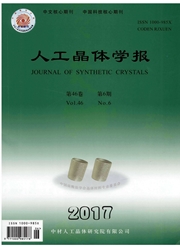

 中文摘要:
中文摘要:
A series of diamond crystals doped with hydrogen is successfully synthesized using LiH as the hydrogen source in a catalyst-carbon system at a pressure of 6.0 GPa and temperature ranging from 1255 C to 1350 C.It is shown that the high temperature plays a key role in the incorporation of hydrogen atoms during diamond crystallization.Fourier transform infrared micro-spectroscopy reveals that most of the hydrogen atoms in the synthesized diamond are incorporated into the crystal structure as sp 3-CH 2-symmetric(2850 cm-1) and sp 3 CH 2-antisymmetric vibrations(2920 cm-1).The intensities of these peaks increase gradually with an increase in the content of the hydrogen source in the catalyst.The incorporation of hydrogen impurity leads to a significant shift towards higher frequencies of the Raman peak from 1332.06 cm-1 to 1333.05 cm-1 and gives rise to some compressive stress in the diamond crystal lattice.Furthermore,hydrogen to carbon bonds are evident in the annealed diamond,indicating that the bonds that remain throughout the annealing process and the vibration frequencies centred at 2850 and 2920 cm-1 have no observable shift.Therefore,we suggest that the sp 3 C-H bond is rather stable in diamond crystals.
 英文摘要:
英文摘要:
A series of diamond crystals doped with hydrogen is successfully synthesized using LiH as the hydrogen source in a catalyst-carbon system at a pressure of 6.0 GPa and temperature ranging from 1255 C to 1350 C.It is shown that the high temperature plays a key role in the incorporation of hydrogen atoms during diamond crystallization.Fourier transform infrared micro-spectroscopy reveals that most of the hydrogen atoms in the synthesized diamond are incorporated into the crystal structure as sp 3-CH 2-symmetric(2850 cm-1) and sp 3 CH 2-antisymmetric vibrations(2920 cm-1).The intensities of these peaks increase gradually with an increase in the content of the hydrogen source in the catalyst.The incorporation of hydrogen impurity leads to a significant shift towards higher frequencies of the Raman peak from 1332.06 cm-1 to 1333.05 cm-1 and gives rise to some compressive stress in the diamond crystal lattice.Furthermore,hydrogen to carbon bonds are evident in the annealed diamond,indicating that the bonds that remain throughout the annealing process and the vibration frequencies centred at 2850 and 2920 cm-1 have no observable shift.Therefore,we suggest that the sp 3 C-H bond is rather stable in diamond crystals.
 同期刊论文项目
同期刊论文项目
 同项目期刊论文
同项目期刊论文
 HPHT synthesis of boron and nitrogen co-doped strip-shaped diamond using powder catalyst with additi
HPHT synthesis of boron and nitrogen co-doped strip-shaped diamond using powder catalyst with additi Characterization of typical infrared characteristic peaks of hydrogen in nitrogen and hydrogen co-do
Characterization of typical infrared characteristic peaks of hydrogen in nitrogen and hydrogen co-do Synergistic effect of nitrogen and hydrogen on diamond crystal growth at high pressure and high temp
Synergistic effect of nitrogen and hydrogen on diamond crystal growth at high pressure and high temp Effects of Fe additive on diamond crystallization from carbonylnickel powders-C system under HPHT co
Effects of Fe additive on diamond crystallization from carbonylnickel powders-C system under HPHT co Multiseed Method for High Quality Sheet Cubic Diamonds Synthesis: An Effective Solution for Scientif
Multiseed Method for High Quality Sheet Cubic Diamonds Synthesis: An Effective Solution for Scientif Growth and annealing study of hydrogen-doped single diamond crystals under high pressure and high te
Growth and annealing study of hydrogen-doped single diamond crystals under high pressure and high te Effects of carbonyl nickel powders on {100}-oriented single diamond under high pressure and high tem
Effects of carbonyl nickel powders on {100}-oriented single diamond under high pressure and high tem 期刊信息
期刊信息
